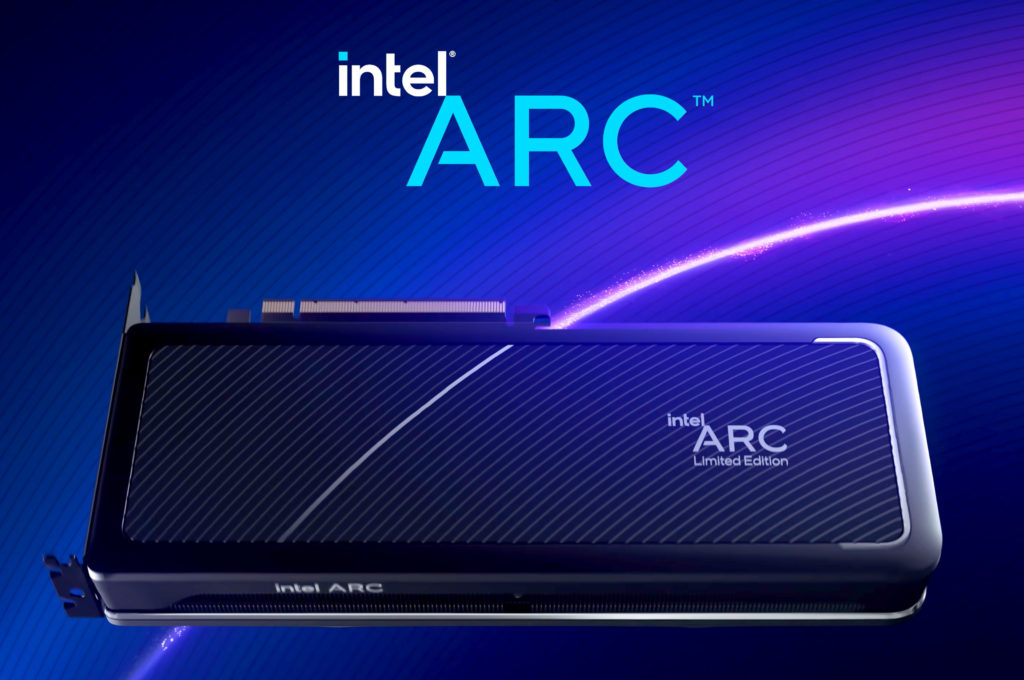Intel Arc discrete graphics cards performance doesn't fare well in early tests
After missing previous 2021 and Q1 2022 deadlines, Intel Arc discrete desktop graphics cards with the Xe HPG gaming architecture went on sale in China this month. But instead of some bombastic arrival, Intel is releasing them rather quietly, first only in China and only in the OEM market. But maybe that’s because they’re not really impressive yet – the first Arc A380 model seems to be falling well short of expectations in tests.
Intel has so far only launched the weaker of the two Alchemist-generation GPUs, the ACM-G11, for the desktop market. The Arc A380 card represents the full configuration of this chip, which has 1024 shaders (8 Xe Cores), 8 ray tracing units and 128 XMX units for AI applications, plus 4 MB of L2 cache and 96-bit GDDR6 memory with a capacity of 6 GB (at an effective clock speed first announced as 16.0 GHz, but later corrected to 15.5 GHz). The clock speeds are somewhere above 2000 MHz and vary depending on whether the card has the reference power draw of 75W or is overclocked.
The specs make this card a fairly low-end offering. At first it was stated that according to official information it should be 25 % more powerful than Radeon RX 6400, but this was a mistranslation from Chinese, in fact the card was supposed to be this much better in price/performance ratio. After taking into account the theoretically significantly lower price (in practice, we still have to see that lower price, maybe in time when prices stabilize, so far they are said to be no lower), it turned out that the alleged performance advantage is only a few percent over the Radeon RX 6400.
This would mean that the full-fat version of the GPU, with 1024 shaders of Intel’s Xe HPG “Alchemist” architecture, is barely enough to compete with AMD’s RDNA 2 architecture Navi 24 GPU when it’s trimmed to just 768 shaders, but against its full-sized version, which has the same 1024 shaders, it’s no longer up to the task.
But early independent tests show that this was not the last disappointment from the Arc A380. Apparently, it is very much hampered by the quality of the drivers. Initial tests show that its real-life performance is sometimes significantly below the results it achieves in synthetic tests like 3DMark, whose preliminary leaked results made it look more powerful than what is now being delivered.
Tests from sites like MyDrivers have surfaced on the web, and in aggregate, they show the Arc A380 to be slower than both the GeForce GTX 1650 GDDR6 based on a 12 nm GPU (which has 11 % more performance) and the Radeon RX 6400 (which has 9 % more performance). Intel only managed to beat Nvidia’s older (but still selling) 2016 GeForce GTX 1050 Ti graphics with a 16 nm Pascal architecture chip, which had only 77 % of the Arc A380’s performance.
These, by the way, should be test results for Gunnir’s non-reference OC Arc A380 graphics card, which has increased TDP and clock speeds, so with reference parameters and the 75W limit it would probably turn out a bit worse.
However, the fact that the Intel Arc A380 card ultimately performs below the Radeon RX 6400 (AMD’s cheapest RDNA 2 architecture model) seems to be acknowledged by Intel’s internal documents as well, or rather the benchmark performance table that Intel supplies to reviewers as reference that can be used to sanity-check results. It was published by the WCCFtech website and you can see in it that while Intel says the Intel Arc A380 is supposed to have higher performance than the low end AMD in some games, in the majority it ends up below which means the average is slower than RX 6400 too…
Performance is worse if the CPU is not from Intel
This all however applies to tests performed with an Intel processor. But there numbers measured on the Ryzen 5 5600 processor have meanwhile surfaced and show an interesting thing. Although a card with such relatively low performance shouldn’t be limited by CPU performance, Intel Arc A380 graphics achieves significantly worse FPS in games when running on a computer with an AMD processor. The impact is smaller in some games, but dramatic in others. Across several games used in a test published on Bilibili, the Arc A380 loses 17 % performance on average when used with a Ryzen processor.
The reason is not entirely clear. It’s possible that the GPU’s driver is simply not sufficiently tested on a competing platform, and there are issues left in it that would otherwise have been fixed by the developers (it would be funny if Intel has actually fallen victim to the notorious deliberate deoptimizations its own compilers would apply on competitor’s processors, for example by not using available SIMD instructions on them).
https://t.co/EAaiYvG5bk
It's even worse on AMD's platform.? pic.twitter.com/lb6bKpqtQy— Greymon55 (@greymon55) June 23, 2022
Theoretically, this could also be caused be some incompatibility or improperly tuned interaction with AMD Smart Access Memory. According to Intel, Intel graphics cards need this technology (labelled PCIe Resizable BAR on Intel platforms) for optimal performance.
Anyway, this poor performance with AMD processors might be a thing that Intel will eventually fix. Maybe such signs of driver immaturity are the reason why the release of the cards has been delayed and why the launch is so limited and slowly staggered (only one card at first, only in China, only OEM…).
Sources: MyDrivers, WCCFtech, VideoCardz, Greymon55
English translation and edit by Jozef Dudáš, original text by Jan Olšan, editor for Cnews.cz
⠀
